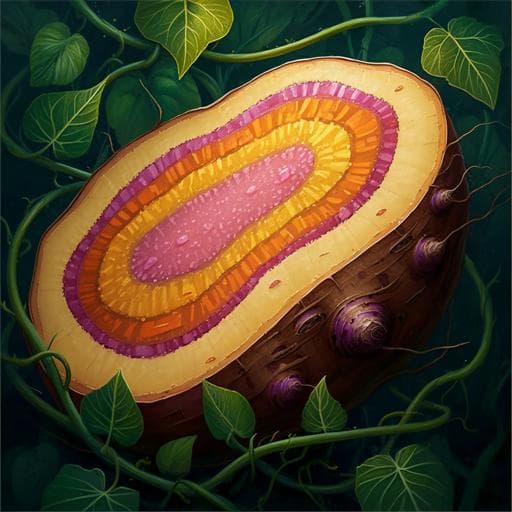
Agriculture
Chromosome evolution and the genetic basis of agronomically important traits in greater yam
J. V. Bredeson, J. B. Lyons, et al.
Unlock the potential of greater yam, a vital crop for food and income security, with groundbreaking genomic research by Jessen V. Bredeson and colleagues. This study reveals critical insights into resistance to diseases and tuber quality traits, paving the way for innovative breeding strategies to adapt to diverse environments.
~3 min • Beginner • English
Introduction
Yams (genus Dioscorea) are a major staple and income source across tropical and subtropical regions, especially in West Africa’s yam belt. Greater yam (Dioscorea alata) is widely cultivated due to high yield potential, adaptability, storability, and nutritional quality, but breeding is challenging because of long growth cycles, erratic flowering, and polyploidy. Anthracnose disease caused by Colletotrichum gloeosporioides severely constrains production, causing up to 80% losses. There is a pressing need for genomic resources to accelerate breeding for disease resistance, yield, and tuber quality traits. This study aims to produce a chromosome-scale reference genome for D. alata, develop dense genetic linkage maps from multiple breeding populations, elucidate chromosome evolution and ancient polyploidy in Dioscorea, and map QTL underlying anthracnose resistance and tuber quality to enable marker-assisted and genomic selection in yam.
Literature Review
The study situates D. alata within the context of recent Dioscorea genomics: chromosome-scale assemblies exist for D. rotundata (white/Guinea yam) and D. zingiberensis (peltate yam), and a de novo assembly for D. dumetorum (trifoliate yam). Prior QTL mapping in D. alata identified anthracnose resistance loci using AFLP and EST-SSR markers and GBS-based SNPs, and a high-density genetic map and sex-determination locus have been reported. However, results have been inconsistent across studies, potentially due to diverse parental genotypes, pathogen variation, and genotype-by-environment interactions. Broader monocot comparative genomics has documented the core monocot-wide tau whole-genome duplication. This work leverages and extends these insights with a highly contiguous D. alata genome, multi-parent linkage maps, comparative synteny analyses, and QTL mapping for key agronomic traits.
Methodology
- Reference accession: D. alata breeding line TDa95/00328 (diploid, 2n=40), chosen for moderate anthracnose resistance and extensive use in breeding.
- Sequencing: PacBio CLR long reads (234–235× depth; N50 read length ~15.1 kb), Illumina short reads for polishing (131 million 251 bp PE reads; ~137×), Illumina mate-pair libraries (~2.5, 6, 9 kb inserts), and Hi-C chromatin conformation capture (358.5 million 151 bp PE reads).
- Assembly and scaffolding: Canu v1.7 from longest 110× CLR reads; haplotype filtering with JuiceBox; scaffolding with SSPACE and 3D-DNA; manual curation using Hi-C and genetic maps; polishing with Arrow (2×) and Illumina-based FreeBayes (2×).
- Annotation: RNA-seq (Illumina stranded mRNA) from 12 tissues and ONT Direct RNA Sequencing; transcript assemblies via PERTRAN and PASA; gene prediction with JGI IGC pipeline integrating FGENESH, EXONERATE, AUGUSTUS/BRAKER1; functional annotation via InterProScan; BUSCO completeness assessment; repeats annotated with RepeatModeler and RepeatMasker.
- Mapping populations: Eleven biparental populations (IITA and NRCRI) derived from seven distinct parents (32–317 progeny per cross). DArTseq genotyping, mapping to the reference, QC filtering (≥90% completeness, Mendelian segregation), phasing and imputation with AlphaFamImpute; per-cross maps built in JoinMap and merged with LPmerge into a composite map.
- Hi-C analyses: Inferring A/B compartments (KR-balanced matrices), Rabl architecture assessment, pericentromere identification and centromere localization.
- Comparative genomics: Orthogroup clustering with OrthoFinder across Dioscorea and broader monocots; synteny via BLASTP and collinearity clustering; Ks computation with DIALIGN-TX and SeqinR.
- QTL mapping: Phenotyping for anthracnose (field and detached leaf assay) across years (2016–2019), and post-harvest tuber traits (dry matter, oxidation, flesh color, size/shape, etc.). QTL association via PLINK logistic regression; per-locus Wald statistics; family-wise error control using max(T) permutation (1,000,000 permutations); significance α=0.05. Effect plots and narrow-sense heritability (h²) estimation from genotype means; LD-based QTL interval definition (r < 0.9 thresholds).
- Resequencing and variants: Whole-genome resequencing of eight breeding lines; alignment with BWA-MEM; variant calling with GATK HaplotypeCaller/GenotypeGVCFs; stringent depth and allele-balance filters; final set of 3.05M biallelic SNVs (1.89M confidently genotyped across all), with SnpEff effect annotations. Relatedness/IBD, runs of homozygosity (ROH), and heterozygosity profiling via custom pipelines.
- Organelle assemblies and phylogenies: Plastid and mitochondrial assemblies and phylogenetic analyses of Dioscoreaceae and monocots.
Key Findings
- Genome assembly: 479.5 Mb assembled into n=20 chromosome-scale scaffolds (scaffold N50 24.0 Mb; contig N50 4.5 Mb). Assembly size consistent with flow cytometry (455 ± 39 Mb) and k-mer estimates (~477 Mb).
- Gene annotation: 25,189 protein-coding genes; BUSCO completeness 97.8% (1.5% fragmented); 13,414 alternative transcripts. Extensive functional annotations via Pfam/PANTHER.
- Chromosome organization: Strong anticorrelation between gene and TE densities (r = −0.885); genes and recombination enriched at distal arms; pericentromeres are TE-rich and recombination-poor; homopolymers/simple repeats correlate positively with gene density and recombination. Hi-C reveals Rabl-like interphase architecture and alternating A/B compartments, with A in gene-rich distal regions and B in pericentromeres.
- Comparative genomics and polyploidy: High 1:1 chromosomal collinearity with D. rotundata (n=20). D. zingiberensis (n=10) chromosomes formed via fusions/translocations of ancestral D. alata-like chromosomes. Evidence for two ancient WGDs: (1) Dioscorea lineage-specific ‘delta’ duplication (median Ks ~0.869 for 1,578 paralog pairs), with large-scale segmental homoeology and rearrangements (centric insertions, fusions) retained; (2) core monocot ‘tau’ duplication (median Ks ~1.21), shared with grasses, pineapple, palm, asparagus. Biased fractionation: Across 11 homoeologous chromosome pairs, consistent asymmetric gene retention supports paleo-allotetraploid origin of delta (rejects autotetraploidy, p ≤ 2.9×10−3).
- Genetic maps: Ten high-concordance linkage maps combined into a composite map spanning 1,817.9 cM with 10,448 well-ordered markers (Kendall’s tau 0.9989), corroborating assembly structure and aiding orientation.
- QTL for anthracnose resistance: In TDa1402 field trials, major QTL on Chr5 at ~23.3 Mb (corrected p = 1.69×10−4) explaining 48.2% of phenotypic variance (additive effect); minor QTL on Chr19 at ~8.37 Mb (p = 1.25×10−2; 29.9% variance). Candidate genes include an EIX1/2 receptor-like LRR (Chr5) and EMSY-like, NB-ARC RGA, and EDR2-domain genes (Chr19). In TDa1419 detached leaf assays (3-year mean), a smaller-effect QTL on Chr6 at ~0.061 Mb (p = 1.28×10−2; 7.3% variance); year-specific data not significant.
- QTL for tuber traits: Oxidative browning QTL on Chr18 in two populations: TDa1419 at 26.50 Mb (p = 5.86×10−3 at 30 min; 13.67% variance; and p = 1.38×10−2 at 180 min; 11.88% variance) near a peroxidase gene cluster (26.23–26.36 Mb); TDa1427 at 24.50 Mb (p = 4.52×10−6; 31.3% variance). Dry matter content QTL on Chr18 at 25.07 Mb in TDa1419 (p = 2.27×10−2; 10.2% variance). NRCRI phenotyping identified QTL for tuber size (Chr12: 0.311 Mb; p = 4.19×10−2; 28.9% variance) and shape (Chr7: 3.116 Mb; p = 3.17×10−2; 34.1% variance).
- Diversity and breeding line genomics: 3.05M SNVs cataloged (1.89M confidently genotyped); 305.5k coding SNVs (127.1k nonsynonymous). Identity-by-descent analysis among eight key breeding lines reveals multiple parent–child and second-degree relationships, extensive recent inbreeding, long runs of homozygosity (often pericentromeric), and blocks of unusually high heterozygosity (>17.5 SNVs/kb) consistent with historical interspecific introgression (likely from D. nummularia). Observed fixation of certain haplotypes (e.g., Chr20) suggests selection in breeding materials.
Discussion
The chromosome-scale D. alata reference and dense multi-parent linkage resources directly address the lack of genomic tools for this orphan crop, enabling precise dissection of trait architecture and accelerating breeding. Discovery of a major-effect anthracnose resistance locus on Chr5, additional loci on Chr19 and Chr6, and robust QTL for post-harvest oxidation and dry matter content demonstrate immediate opportunities for marker-assisted selection. Candidate genes within QTL intervals provide mechanistic leads for disease resistance and oxidative browning pathways (e.g., LRR receptors, EMSY-like immune regulators, NB-ARC RGAs, and peroxidases). Evolutionary analyses reveal that Dioscorea experienced an ancient paleo-allotetraploidy (delta) with biased fractionation, followed by extensive rearrangements, and retains the older core monocot tau duplication, providing a framework for interpreting genome structure and gene family evolution. The relatedness and ROH patterns among breeding lines highlight a narrowed genetic base and underscore the need to introduce novel alleles while leveraging putative adaptive introgressions. The integrated genomic toolkit supports marker-assisted and genomic selection, GWAS, and gene editing in yam improvement programs.
Conclusion
This study delivers a near-complete chromosome-scale D. alata genome, comprehensive annotation, and the highest-resolution genetic linkage map to date for the species. It uncovers Dioscorea chromosome evolution through two ancient WGDs (delta and tau) with evidence for paleo-allotetraploidy and biased fractionation, and maps eight significant QTL for anthracnose resistance and key tuber quality traits. The resources enable efficient marker-assisted breeding, genomic selection, and candidate gene prioritization, and pave the way for genome editing to rapidly improve elite germplasm. Future work should validate QTL across environments and germplasm, broaden the genetic base by incorporating diverse and wild accessions, resolve the sources and impacts of introgressed segments, generate additional high-quality assemblies to characterize structural variation, and integrate genomic predictions into yam breeding pipelines.
Limitations
- QTL reproducibility varied by year and environment; anthracnose resistance QTL showed year-specific significance, and detached leaf assay phenotypes were not consistently correlated across years, indicating strong environmental influences. Validation in independent populations and environments is needed.
- Some mapping populations had modest sample sizes (n ~43–97 for certain traits), limiting power to detect small-effect loci.
- Candidate causal genes within QTL intervals remain unvalidated functionally.
- Breeding line analyses revealed high relatedness and extensive ROH, potentially limiting allele diversity and generalizability; broader, less-related germplasm should be surveyed.
- Comparative inferences about D. rotundata chromosomal differences may be impacted by limitations in the D. rotundata assembly, especially around pericentromeres.
- While evidence suggests interspecific introgression, the donor species and functional impacts require confirmation with broader sampling of related Dioscorea species.
Related Publications
Explore these studies to deepen your understanding of the subject.







